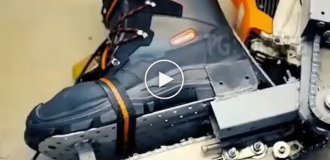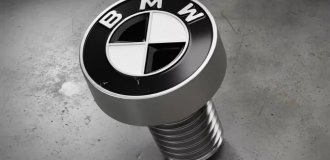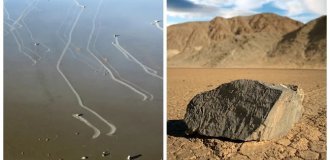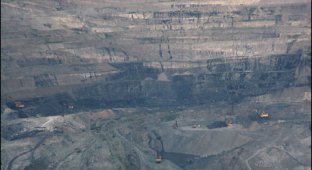How limestone is mined (64 photos)
Detailed production report from the quarry of the Sokolsko-Sitovskoye flux limestone deposit, located a couple of kilometers northeast of Lipetsk. Below the cut are large excavators, BelAZ trucks, a factory, conveyors, an explosion and much more...

Some official dаta: The quarry is developed by JSC Studenovskaya Joint-Stock Mining Company, currently the company is part of the NLMK Group and is one of the Russian leaders in the production of fluxing limestone, used mainly in the metallurgical industry and construction.

Production volumes account for more than 15% of mined fluxed limestone in Russia.

The dimensions of the quarry are impressive: 1500x500 meters, and depth - 50 meters. Here you can easily build more than 10 football fields or lay out a track for Formula 1...

According to geologists, the reserves of raw materials in the quarry at the current capacity will be enough for at least 30 years of operation.

Limestone is a widespread sedimentary rock formed with the participation of living organisms in marine basins. Once upon a time, approximately 350-370 million years ago BC, in the Devonian period of the Paleozoic era, the Lipetsk region, like many regions of central Russia, was a sea. Often in rock fragments you can find fossil remains of ancient life of those years...

The deposit is being developed by open pit mining. The technological process of mineral extraction can be divided into the following main types of work:
Stripping works
Mining works
Dumping and mining reclamation
Transport work
Mineral processing

Stripping works.
First, using a bulldozer or loader, the top fertile layer of soil, chernozem, is removed and stored for subsequent reclamation of lands disturbed by mining. Next comes a clay layer about 20 meters thick, which is mined by electric excavators with a bucket capacity of 8 - 10 cubic meters. Stripping operations also include partial removal of substandard (low-quality) limestone, which is located directly under the clay layer.

This photograph clearly shows a slice of the “quarry pie”: a layer of clay, a layer of substandard limestone and a smooth ledge of minerals. The crumbling hill of limestone under the ledge is a consequence of the explosion. It is these “consequences of the call” that are loaded into BelAZ trucks and taken to the factory. And all overburden rocks are taken to an internal dump.

Mining work.
It is customary for miners to say extraction, with the emphasis on the first syllable. The actual extraction of limestone is preceded by drilling and blasting operations - the most spectacular part of the entire process.

A solid layer of limestone that cannot be scooped up with an excavator bucket has to be drilled, explosive materials placed in it and blasted. Drilling rigs of the SBR type, powered by electricity, are used for drilling.

The drilling rigs are serious, they drill holes with a diameter of 16 cm to a depth of up to 24 meters (7 floors). Drilling one well takes 50 minutes. A string of wells, stretched out in a line, is drilled one after another 5 meters from the edge of the cliff.

Brave driller!

For the explosion, industrial and conversion explosives are used, the acquisition of which requires a whole bunch of various permits and licenses, as well as special transport for transportation and armed guards. You can't just buy gunpowder at the market...

TNT blocks serve as a detonator.

On average, to carry out one explosion, about 30 wells are drilled, into which a total of 5-6 tons of explosives are placed.

A detonating cord is used to connect all wells with explosives into a single chain.

An explosion is a very important matter! The quarry is completely cordoned off, and guards are posted in the area of the future explosion. All equipment is moved to a safe distance, and BelAZ trucks generally leave the quarry. Before the explosion, all cordon posts are surveyed by radio and the situation is clarified. If everything is normal, permission is given to carry out blasting operations. (The security post and transformer booth are also being taken away).

The wells are not exploded simultaneously, but with a delay of a few hundredths of a second, otherwise there will be an earthquake, and the glass of most of the buildings in Lipetsk will fly out.

For a sense of scale, on the right side of the frame there is an excavator the size of a 4-story building... Small pieces of rock can fly away to a distance comparable to the height of the main building of Moscow State University - 250 meters.

You can see how heavy pieces of solid rock are separated from the ledge in even rows and fall down.

The entire explosion takes place in a few seconds and is clearly audible in the city. This is what collapsed rock looks like. After the smoke clears and the dust settles, the blasters will check for undetonated charges, after which the excavators and BelAZ trucks will get down to their work.

The rock is loaded into BelAZ using a mechanical shovel (that is, an excavator), or more precisely, using a self-propelled full-rotary excavator-loading machine. This monster runs on 6,000 volts of electricity, the photo shows the high voltage cable that powers the excavator's motors. In one day of operation, the machine consumes as much energy as an ordinary nine-story residential building does in a week.

At one time, the excavator can load 10 ordinary photographers, or 20 Chinese photographers.


The weight of such a bucket is 16 tons.

Each excavator employs two people to ensure continuity of the production process.

In total, the quarry operates 6 large excavators (buckets with a volume of 8 and 10 cubic meters) and 2 smaller ones, with a bucket volume of about 5 cubic meters.

Sometimes equipment breaks down. For example, the main gear of this excavator has failed and is being repaired right in the quarry. The diameter of the limply hanging steel ropes is 4 cm.

And this is a now decommissioned veteran who honestly gave about 40 years to the enterprise. Despite his advanced age and shabby appearance, grandfather, in case of emergency, can be taken to work in the quarry.

Dumping and mining reclamation.
At a constant depth, the quarry bowl constantly moves in the direction in which the limestone lies. On one side of the quarry, overburden is removed and limestone is extracted, on the other, the mined-out space is filled with overburden rocks, limestone crushing screenings and black soil.


Screenings formed after crushing limestone and unsuitable for use are brought in dump cars from the crushing and processing plant. The excavator dumps everything onto the dump, filling the mined-out space of the quarry. Then the dumps will be covered with previously uncovered soil and black soil on top.

This mechanical shovel is smaller - with a 5 cubic meter bucket.

Next, the land is plowed and biological reclamation is carried out - sowing the land with useful plants. In a few years, the reclaimed land can be used again for agricultural purposes. Previously, the quarry started right from the plantings (on the right in the frame) and over the course of 20 years it moved 600 meters. Now there is a field. In the future, the quarry may advance another 2.7 kilometers.

Transport work.
Every day, 12 BelAZ trucks work on the line in the quarry, which ensure the transportation of overburden rock to dumps, and the mined limestone to the crushing and processing plant.

Belazitists work around the clock in three shifts, eight hours each. BelAZ makes up to 100 trips per day and transports up to 16 thousand tons of mined limestone. In three months the car covers the distance from Moscow to Vladivostok.

The carrying capacity of such a BelAZ is 55 tons, more than its own weight. BelAZ trucks with a higher carrying capacity are not practical to use in this quarry for several reasons: quarry depth, transportation distance, production volume, and so on. This baby mammoth is driven by a 700 l/s diesel engine.

If, during transportation from the BelAZ trucks, something falls onto the road, for example a large stone, a special wheeled bulldozer will remove it back into the face, to the excavator.

They are actively fighting dust in the quarry; the roads are constantly sprayed with a special sprinkler. And in winter, watering is replaced by sprinkling with a sand-salt mixture.

To take this shot, I had to ask the driver on the radio (every piece of equipment in the quarry is equipped with a radio station) to drive off the watered road. The permissible speed in the quarry is 20 km/h.

The quarry has 14 km of technological roads built using the bulk method, there is also electrification and substations to power excavators. The roads are excellent; you can easily navigate them in a car.

BelAZ repair and maintenance shop.


The body and engine of this BelAZ were removed.

The extracted minerals are brought to the processing plant and loaded into a receiving bunker. Before this, the dump truck is weighed and the weight of the cargo is obtained by simply subtracting the weight of the empty BelAZ.

Reception bunker.

Mineral processing.
This is the first building of the factory - a large crushing building. Here, the jaw crusher coarsely crushes large pieces of rock. The resulting fractions are up to 10 cm in size.

Further along the conveyor, the material enters the medium crushing housing.

Approximately 15,000 tons of rock are transported along the conveyor belt per day.

The cone crusher performs medium crushing.

A clever system of vibrating screens. In closed devices, products are divided into fractions (according to the size of the stones) and distributed along conveyors.

The workshop can easily fit an ordinary five-story house...

Very fine limestone - screenings up to 1 cm are sent for unloading into dump cars for subsequent transportation to the quarry dump.

Sorting and loading building. The finished product is delivered here, where it is loaded into railway cars. The main consumer of the products is Novolipetsk Iron and Steel Works


One car contains 69 tons of crushed stone.


Loading into vehicles takes place nearby.

Work in the quarry does not stop at night. For this purpose, backlighting works on excavators.


UFO.

The 55-ton BelAZ trucks used in quarry work are relatively small, and by miners’ standards they are just small. Someday I will definitely look at the work of 320-ton trucks!

The night quarry and factory are beautiful!

I would also like to say something about the people with whom I worked for two filming days. Open, kind, cheerful miners, happy to talk about their work and technology. Real men!






















